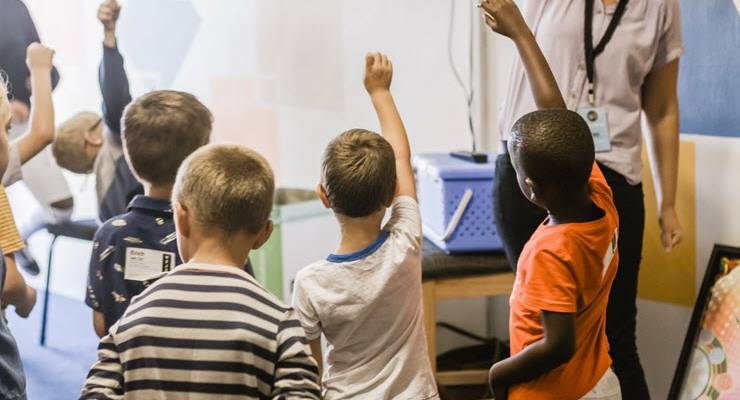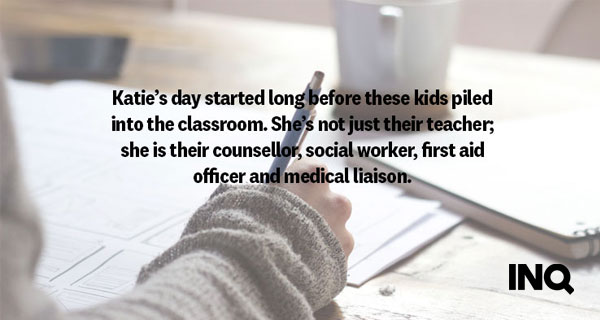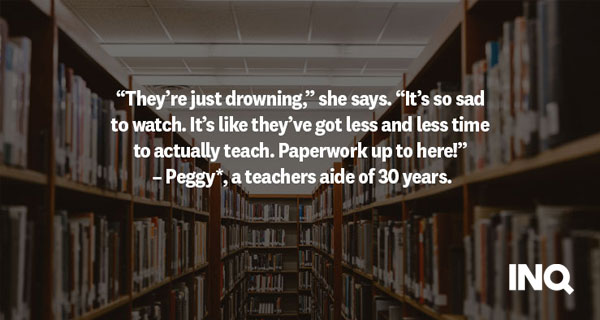
This is the second instalment in a two-part series. Read part one here.
Katie* is a first-year-out graduate teacher at a regional New South Wales primary school. She found the job overwhelming when she began just four months ago. The practical challenge of wrangling 20 demanding six-year-olds seemed near impossible at first. But now she has found a novel way to bring the room to a standstill.
“Yeeeeeeear ooooone,” Katie sings, drowning out the hubbub of squeals and indignant debates about dinosaurs versus bugs.
“Kaaaaaa-tieeeeeee,” the children sing back as they turn towards their teacher. Before they know it, their eyes are locked on hers, mouths quiet as she places a finger to her lips.
The raw energy of a grade one classroom on a Monday morning is like being inside a football locker room before a big match. Less testosterone, more of a Wiggles vibe, but with the same intense mix of personalities and excitement (and occasional lust for violence) swirling around in a confined space. Frankly, I find it slightly terrifying.
Within a few seconds, Katie has the room.
“Thank you, year one,” she says with a warm smile. “Now let’s form the morning circle.” Tiny hands find each other, little fingers entwine, and the children form a ring on the carpet.

Class has just begun, but Katie’s day started long before these kids piled into the classroom. She’s not just their teacher; she is their counsellor, social worker, first aid officer and medical liaison. All these roles are additional to the core business of teaching the curriculum.
Already today, she’s been briefed on how to manage one student’s dietary needs (his medication is affecting his appetite) and another’s asthma diagnosis (the girl’s father came in to show Katie how to help her use the inhaler). Her seemingly innocuous small talk with the children about their weekends as they arrived was actually intelligence-gathering for the school well-being officer, who is checking in on one particular family.
Because there are so many kids in this group requiring special attention, Katie has been assigned a teacher’s aide for the year. Sue* is there to help with pretty much everything: keeping kids focused, handing out notes to take home, escorting students in and out of the classroom when they have one-on-one sessions with a counselor or reading specialist.
Nine of Katie’s students are on “individualised plans” (IPs), designed to cater to a particular learning difficulty, medical diagnosis, behavioural problem or social need. These plans are generally updated once a term — though sometimes as frequently as every two weeks, with each update requiring a meeting with the child’s parents. I ask what would be different if those IPs didn’t exist. “Nothing,” she says, “I’d be doing all the same things in practice. It just wouldn’t be documented.” The IPs sound burdensome, but Katie acknowledges they can be valuable for communicating with parents and tracking what you’re doing.
Seven of Katie’s students are diagnosed with ADHD. Five have recently started new medication, meaning that Katie must fill out an ADHD Symptom Scale for each child, at the start and end of a three-week period, and observe any changes in behaviour, mood, cognition and appetite. She must also take daily notes to be shared with the child’s parents and doctors.

Katie has no idea whether anyone reads her pages of notes in any detail. “I just know I have to provide them, so I do the best I can,” she says. If the student’s medication changes again, which frequently happens, the whole process is repeated.
(Katie later explains that before any ADHD assessment can be made by a GP, let alone a medication trial, a teacher must fill out a 113-question assessment survey, as well as provide extensive behavioural observations).
I note all this not to open up a debate about the rates of ADHD diagnosis — which is a whole other kettle of fish — but simply to show how teachers are burdened with responsibilities that go well beyond the pure task of educating children.
The Education Department, I soon discover, issues plenty of its own tasks.
Today, for example, Katie is introducing the class to the digraph “ow”, a fine example of what a nightmare the English language is to teach — and what a good job our teachers do of it.
Katie asks the children to think of words that end in “o-w” but sound like “oh”. She lists them on the board in purple chalk, underlining the “ow” in pink:
bow
blow
crow
pillow
window
A girl with a braid is invited to give the class a clue for the next word.
“Um… it is in winter,” the girl says.
A dozen hands fly up. A boy in the middle row rocks on his stool, yelling out the answer (I later learn the wobbly stool is a “sensory posture” chair, designed to help fidgety ADHD students stay focused). Katie reminds him not to interrupt without putting up his hand. “Oh yeah, sorry about that!” he shouts. She calls on another boy to respond.
“Snow,” he says, with the confidence of a first-round contestant on Who Wants to be a Millionaire?. His happy cheeks flush pink as Katie adds it to the list.
Just as she’s about to move on, someone suggests “no”, as in “yes-or-no”, and Katie has to explain why “no” isn’t an example even though it sounds like it — but that there is “know” which, remember, has a silent “k” — and that “no” with a “w” is actually pronounced “now”, which makes a different sound, to rhyme with “cow”.
Katie satisfies the curiosity of her students, but is apparently not trusted to do so without “proving” it. To keep her teacher accreditation with the NSW Education Standards Authority (NESA) she must provide “work samples” for each lesson she runs.
“So I was walking around the class taking photos of the kids’ work to show I did my job,” she explains during recess. (The type of “evidence” teachers provide is determined by individual schools. Most opt for images.) She uploads the pictures and add notes about how the class went into her daily planner, for when the school is audited. “There’s no trust.”
No trust, and no apparent recognition that time is finite.
It’s time to practise writing.
The children hunch over their workbooks and stick out their tongues, concentrating on producing legible scrawl. Katie makes her way around the room to check on each child’s work, show them how to better grip their pencils, asks a few to write a whole sentence at the bottom of their page. She pauses at one student’s desk, congratulates him then gently corrects his syntax. I hear the soft “ahhhhh” as the penny drops for him — a learning moment, the point of this whole exercise.
Some of the children have been told to choose one of the words from the list on the board and draw a picture of it. One girl announces she’s picked “tomorrow”. Katie looks slightly sceptical, and suggests she might want to choose one of the other words. I’m thinking the same thing. It’s one of those abstract words adults struggle with in a game of Pictionary — but the girl promptly draws a nighttime scene, followed by a daytime scene. Katie and Sue smile at each other, impressed. It’s a sweet reminder that adults can sometimes overthink what in a child’s mind makes perfect sense.
While the rest of the class is occupied on their own set tasks, Katie spends some time at the back of the room practising phonics with Ben. He started the year late, so she needs to catch him up as best she can. They sit cross-legged on the floor, as she takes him through different letters on a laminated printout and plays a short mnemonic song on a portable speaker to sing along with for each sound.
A – a – a – ants on my arm, they’re causing me alarm
S – s – s – snakes in the grass – s – s – s
They are interrupted when another boy comes over to show Katie his alphabet practice. She notes that he’s got his “P” around the wrong way. He goes away to try again. Ben continues. He knows a lot of the jingles by heart — Katie tells him she’s happy to see he’s been practising at home.
T – t – t – when I watch a tennis game – t – t – t
The hubbub in the class starts to rise. Katie sings out. “Yeeeeeeear ooooone”. The noise drops. The other boy comes back with a row of right-facing Ps. Katie tells him he’s done a great job and sends him back to his desk.
C – c – c – clicking castanets – c – c – c
K – k – k – kites are flying in the sky – k – k – k
Before Katie can finish going over the fact that both “c” and “k” can make the same sound with Ben, a debate breaks out in the front row about whether the Easter bunny is real or not. One student accuses another of having poor eyesight. “I do not!” she protests. The boy on the squirmy chair is starting to look like he’s riding a mechanical bull. Sue takes it away from him, he bangs the table. She has him take a deep breath to calm down.
Katie wraps up with Ben and tells him they’ll finish tomorrow. They’ve been going for about 10 minutes. She’s lucky to get snatches of time much longer than that.
[hr]

At lunch time, I stand with Peggy.* She’s been a teachers’ aide for 30-something years. She eats a sandwich out of a brown paper bag, a careful eye on the children scattered across the playground.
She asks what I’m doing here. I explain I’m working on a story about teachers’ workloads. Has she noticed a change in recent years?
Peggy nods furiously.
“They’re just drowning,” she says. “It’s so sad to watch. It’s like they’ve got less and less time to actually teach. Paperwork up to here!” She holds her hand above her head. “You’ve got to wonder whether the bureaucrats who set all the rules have ever set foot in a classroom. It really can’t go on like this — something’s got to give.”
Katie joins us, wolfing down her own lunch. She’s been prepping the classroom for the next lesson. (Desks needed to be rearranged, certain spots reserved for certain students in what sounds like an exercise in human Sudoku: Some kids have receptive language disorders, so they need to sit at the front of the class so that Katie can address them “directly, repeatedly and with actions so that they understand”. Some have vision needs that mean they need to be a set distance from the board, others are put in particular places for behavioural reasons. And yes — of course — these measures are all documented.)
Peggy warily asks Katie how the day’s going. The grade one class is known as one of the most challenging in the school. Katie laughs. “The kids definitely know they’re being watched. They’re never this well-behaved,” she says, incredulous. “Never. I can’t believe how good they’re being. I mean, it’s great!” she turns to me, “but you’re not getting the full sense of how chaotic it can be in there — trust me.”
I tell her I believe her — and that even with the observer effect in full swing I can see how exhausting it is. The whole day she’s been spinning plates. I suggest there must be days when one (or more) falls, shattering everything she’s got planned.
There are, she tells me. Like the one a few weeks ago, when one of the students had a total “meltdown”, and she had to evacuate the rest of the class to sit outside for their (and her) own safety while Sue tried to calm the student down. (Strategies for dealing with moments like these are devised in round table meetings, then written up and signed off by the class teacher, parents and principal to be added to a student’s IP.)
“When do you catch that day up?” I ask.
“We do what we can outside the classroom and catch up on the rest the next day.”
The bell goes. The playground empties, as children run, dawdle, and skip back to the buildings.
After lunch, Katie reads the class a book. Extra Yarn by Mac Barnett. “What’s yarn?” asks one boy. “Good question,” says Katie. “Does anyone know what ‘yarn’ is?” “It’s string,” says another boy. “Well actually there’s two types of yarn!” a girl fires back. “There’s the one like wool and there’s the one that means talking.” Again, I find I’ve underestimated a six-year-old.
Katie sits on a chair in the back corner of the room, the children gather around on the floor. One boy lies down at the back of the group, tearing a tissue into a hundred tiny pieces and inspecting the edge of the carpet, but mostly the children are transfixed on the story. A few pages in, a girl lets out an enormous burp. I try not to laugh. “Say ‘beg my pardon’, Maddie,” Katie says. The girls begs it, and Katie continues.
A startling burst of percussion causes major excitement. It’s raining. The children jump up and run to the window. One looks distressed — he starts rubbing his ears and complaining it’s too noisy. Sue walks over to comfort him. Katie indulges the moment — lets the kids press their faces up against the glass, and gaze in awe at the water falling from the sky. When it eases off, she calls them back to the floor, and they finish reading the book.
By the time the final bell goes, I’m drained — and all I’ve done is sit on a chair at the back of the room and watch. The children — only slightly less energetic than they were at the start of the day — gather up their things and race out to meet waiting parents.
The bell doesn’t ring for Katie just yet. She has a staff meeting to attend this afternoon, then will spend about another two hours at home “planning, recording evaluations and completing student observations”. At report-writing time, or when there are parent-teacher interviews scheduled, there’ll be even more out-of-hours work to do — some of it will spill over into her weekend.
I’m in awe of Katie, hugely grateful that people like her see teaching as a vocation, but I wonder how long she’ll be able to keep this up. Burnout seems inevitable. And yet I envy her, in a way: there are so many tiny moments of joy in helping young children learn about the world. I just wish their teachers had more time to savour them. They deserve to.
*names have been changed








Nice to see articles like this on Crikey. Some lovely insights, well written, and refreshingly politics free. I have several friends who are primary school teachers and they have my utmost respect and admiration for the selfless work they do in a thoroughly broken system.
Spot on, Kirsten. Like you, I have seen modern education from the wings. I am also gobsmacked by the medication management and mental health management required of teachers. The neo-cons advocating greater teacher accountability should carefully read and digest what you have documented here.
Overheard in a Victorian State Primary School yard before school this morning. One student is chasing another. “It’ll won’t be a figurative beating, it will be a literal one”. PS Not a real fight.
There’s also the disproportionate number of special needs children in her classroom: surely more than a representative sample of five and six-year-olds. To what extent is this a consequence of private schools having the option of rejecting those kids that require more effort to educate and passing them on to the public system at the same time as fighting tooth and nail for their retention of public funds?
Without wanting to open up the issue of the diagnosis (or otherwise) of ADHD/ADD and autism in general,
all are quite under-diagnosed, and it is very likely because if either are diagnosed, and that diagnosis is confirmed, then the education authorities have to supply the additional resources to assist that child.
However, if it is ignored in childhood, the actual social cost to the individual and society in later life is greater, so it is false economy to ignore the existence of ADHD/ADD and Autism in the education system, when it can be better remedied and consequences reduced.